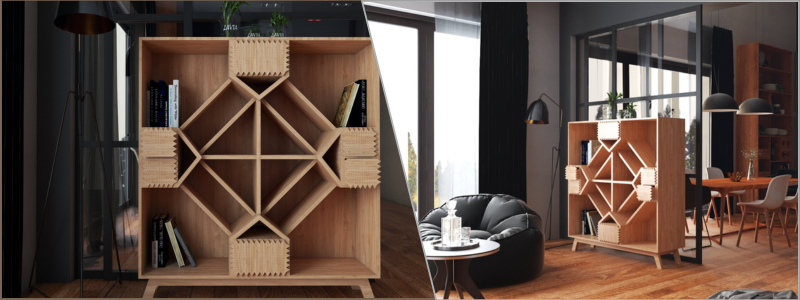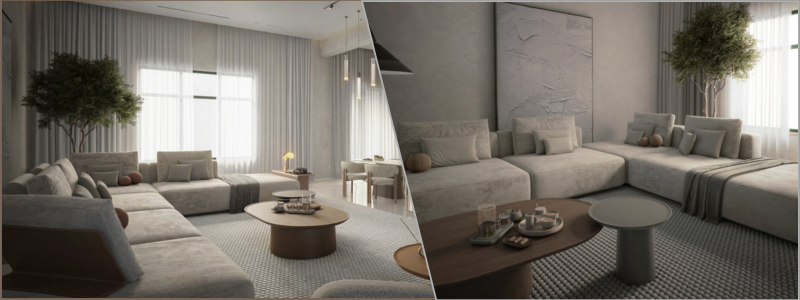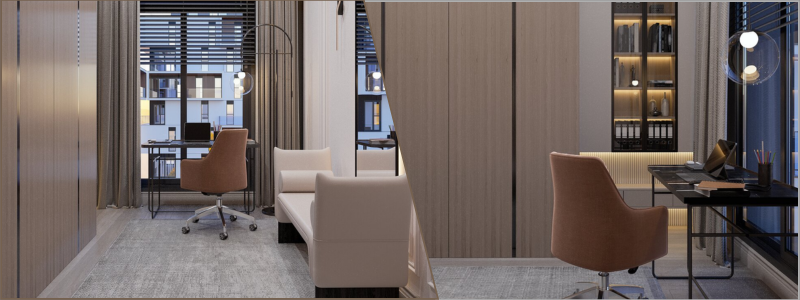Innovating the online furniture shopping process is more critical than ever, and 3D rendering is revolutionizing the way consumers engage with virtual showrooms. Immersive renderings enable customers to discover furniture in realistic detail, see pieces in their own environments, and make confident, knowledgeable buying choices. Firms providing 3D rendering solutions assist brands in developing engaging, immersive shopping environments, while Cad Crowd platforms bridge businesses with experienced freelance designers who render these virtual environments with precision and imagination.
The furniture shopping world has changed beyond recognition over the past ten years. Those days of physically traveling between numerous stores, making manual measurements, and visualizing a product in one’s room are long gone. Now, technological changes—particularly 3D Rendering Services—have revolutionized furniture browsing and buying. Virtual furniture showrooms lead this revolution with hyper-realistic 3D visualizations that enhance customer interaction, belief, and purchasing decisions.
 Table of contents
Table of contents
What are virtual furniture showrooms?
A virtual furniture showroom is an interactive, web-based environment where customers are able to browse, customize, and visualize furniture in a highly engaging digital setting. In contrast to flat product photos, these showrooms utilize 3D rendering services to display furniture richly, with precise materials, lighting, and textures. This enables customers to rotate, zoom, and even position furniture within a virtual layout of their own home using augmented reality (AR) and virtual reality (VR) tools.

RELATED: Top 5 challenges in interior design solved by outsourcing CGI services at freelance CAD firms
Why 3D rendering services are the backbone of virtual furniture showrooms
Virtual furniture showrooms have revolutionized how people shop for office and home furnishings. Gone are the days when shoppers had to travel to a physical store to see an entire range. Buyers now get to view an entire range from the comfort of their homes. But what makes these virtual experiences so immersive and successful? The secret is high-quality 3D rendering services. These services are the backbone that turns virtual showrooms into interesting, informative, and useful experiences for today’s shoppers. That’s why 3D rendering is the cornerstone of this modern shopping experience:
Unparalleled realism
Furniture consumers look forward to viewing the very realistic and lifelike product images prior to purchasing. In contrast to the more basic photographs requiring physical models and perfect lighting, 3D rendering enables the production of realistic digital models. All the minute details—the texture of fabric, the patterns of wood grain, reflective surfaces, and realistic lighting—are carefully crafted to accurately replicate the actual. This degree of realism instills faith in the decision, eliminating uncertainty and hesitation.
Seamless customization & personalization
One of the biggest disadvantages of conventional showrooms is their limited display of inventory. Physical space limitations imply that customers can only view a few design options. With 3D rendering, however, the options are virtually limitless. Buyers can alter fabric colors, upholstery materials, finishes, leg styles, and so on—all in real time. This capacity to personalize products makes the shopping experience more enjoyable and guarantees customers find precisely what they’re searching for. It also enables furniture businesses to accommodate a variety of taste styles without requiring a huge inventory.
Virtual staging for improved decision-making
One of the greatest difficulties shoppers have when they are searching online for furniture is imagining how an item will look in their current room. Will that sectional sofa overwhelm the living room? Does that dining table complement the flooring? 3D rendering-backed virtual staging services tackle this problem. Most virtual showrooms today now come with built-in augmented reality (AR) apps, so customers can easily place 3D-rendered furniture in the comfort of their own homes. This interactive mode guarantees improved decision-making and minimal returns due to mismatched expectations.
Cost-effective marketing for furniture businesses
Physical furniture marketing consumes a lot of costly photoshoots that come with professional shots, lighting designs, and concrete prototypes. Not only is this labor-intensive, but it’s also expensive. 3D rendering eradicates these costs by building photorealistic images on a computer. These digital images are reusable throughout different marketing media, from electronic catalogs and e-commerce sites to social media campaigns and online advertising. The reuse of 3D models on different platforms optimizes return on investment (ROI) for furniture companies.
Speeded-up design & production procedures
Outside of sales and marketing, 3D rendering can also be a significant force in furniture design and production. Designers are able to make and test prototype models digitally before production starts, saving the expense of physical samples. Not only does this accelerate the design process, but it also reduces waste materials. The transition from idea to production is seamless, so companies can get new designs out to the market quicker while keeping costs in line.
RELATED: Shop drawing rates, millwork drafting service costs & finding the right pricing for your company

Improving customer experience through interactive 3D showrooms
Immersive virtual tours
Static e-commerce websites can’t compete with the interactive shopping experience offered by virtual furniture showrooms. Clients are able to tour a virtual showroom through 3D furniture rendering services, see various furniture placements, and engage with products similar to how they would in a physical store.
Live consultations & AI-powered assistance
Several furniture companies incorporate AI-driven chatbots and live consultations into their virtual showrooms. These features guide customers by suggesting furniture according to room size, style, and budget. AI-driven 3D rendering services can even propose complementary furniture items for a uniform design look.
Augmented reality for real-time placement
Augmented Reality (AR) brings virtual shopping to life. Using just a smartphone application, shoppers are able to display 3D-rendered furniture in their own homes, modifying scale and positioning to view how well the piece will fit. This dispels uncertainty and sharply lowers product return rates.
Virtual reality (VR) showrooms for an immersive shopping experience
For the ultimate futuristic experience, a few companies provide VR-enabled showrooms through 3D virtual reality rendering services. With a VR headset, customers can enter a completely immersive virtual store, walk through, lift furniture, and view detailed features at close range—replacing an actual showroom visit with the convenience of being at home.
The role of 3D rendering services in e-commerce success
Online furniture brands increasingly rely on 3D rendering services and 3D modeling design services to increase product listings. Well-rendered images and 360-degree views of products enhance conversion rates drastically because they communicate better than 2D images.
Better product descriptions
Instead of vague descriptions, online marketplaces can offer interactive 3D models to view furniture from any angle prior to buying. This builds greater trust in internet buying.
Fewer product returns
Among the largest problems facing online furniture selling is excessive return rates as a result of expectation mismatch. 3D rendering services close the gap by showing customers the products as they would look like when delivered, diminishing the possibility of post-purchase regret.
Social media engagement
Realistic 3D furniture images look great on social media. Businesses can make interactive Facebook ads, Instagram posts, or Pinterest images that feature furniture in innovative, appealing ways, engaging more prospective buyers.
RELATED: Enhancing parts design and engineering with 3D scanning: a guide for company services & freelancers
Future trends: where virtual furniture showrooms are going
As technology continues to advance, virtual furniture showrooms will continue to become smarter, and furniture design services have made these a mainstay in their service packages. These are some of the exciting trends that are coming:
AI-generated personalized showrooms
Next, AI will create personalized virtual showrooms for individual users based on their user preferences, history of purchases, and home layouts. Rather than shopping at a generic store, consumers will walk into a showroom designed especially for them.
Real-time material simulation
Advanced 3D rendering experts will soon provide real-time material simulation, where shoppers can observe how a fabric responds to light, touch, or wear over time—adding further confidence to purchase.
Blockchain for product authenticity
Blockchain technology could be applied to virtual furniture shopping so that the buyer can check for authenticity, provenance, and sustainability certifications of a product prior to purchase.
AR Shopping with smart home integration
In the future, AR-based furniture shopping can be merged with smart home systems. Buyers may be given intelligent suggestions based on their current interior space, lighting levels, and room requirements.

The future of virtual furniture showrooms
With advancing technology, 3D rendering will become increasingly advanced. Elements such as AI-based customization, improved AR support, and real-time product demonstrations will continue to narrow the differences between online and offline shopping experiences. For furniture businesses that wish to remain competitive, it’s no longer a choice but necessary to invest in quality 3D modeling experts.
In an age where e-commerce is the rule, 3D rendering-based virtual furniture showrooms are changing the furniture purchasing experience. Having the capability to provide hyper-realistic images, hassle-free customization, virtual staging, and affordable marketing are all factors that enable a better customer experience. With the changing landscape of the industry, companies embracing this technology will be the leaders in the online market.
Conclusion: a game-changer for the furniture industry
Virtual furniture showrooms driven by 3D rendering services are changing the way people browse, design, and purchase furniture. Such innovations not only increase customer interaction and satisfaction for interior design companies but also offer businesses cost-effective marketing tools, better design workflows, and lower return rates. As AR, VR, and AI keep advancing, virtual shopping will become even more immersive, with online furniture buying as trustworthy and enjoyable as browsing a physical store—if not more so.
For companies wanting to remain competitive, high-quality 3D rendering services are no longer a choice but a must. These companies will be at the forefront of the next digital furniture retail wave, shaping new norms for how consumers shop and enjoy home furnishings in the digital age.
RELATED: Camera angles in the 3D architectural visualization realm for your projects
Cad Crowd is here to help
Augmenting virtual furniture showrooms with 3D rendering is not merely about generating pretty models—it’s about revolutionizing the shopping experience with realistic detail, interactive customization, and effortless user interaction. Using sophisticated CAD and rendering methodology, businesses are able to present their furniture designs accurately, enabling customers to make informed buying decisions. For companies planning to take their online showrooms to the next level, collaborating with professional experts is the way to go.
Cad Crowd bridges businesses with the best freelance CAD designers specializing in high-quality 3D visualization to make every product shine. From photorealistic images to virtual staging, you can hire an expert to suit your needs. Receive a free quote now and make your virtual showroom shine with state-of-the-art 3D rendering.
The post How 3D Rendering Enhances Virtual Furniture Showrooms & Shopping with Company Services first appeared on Cad Crowd.